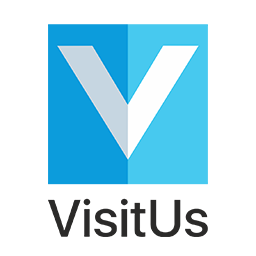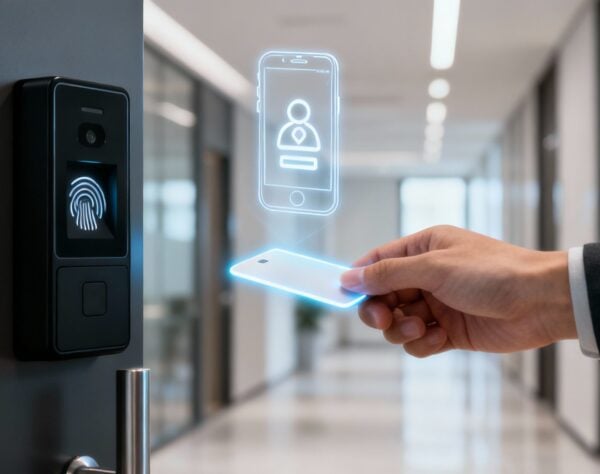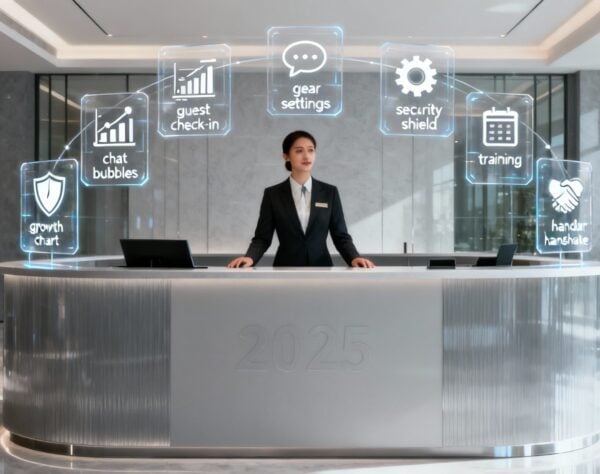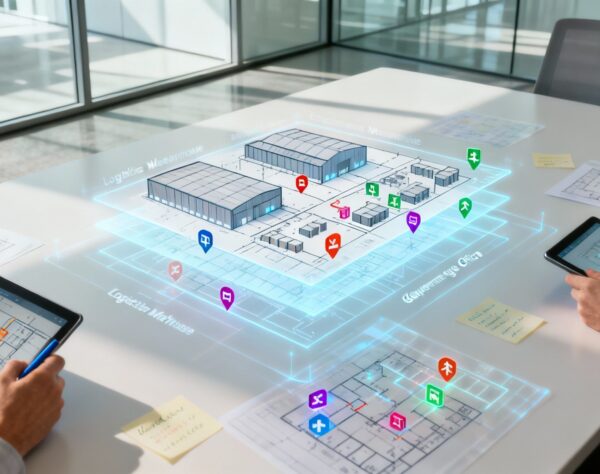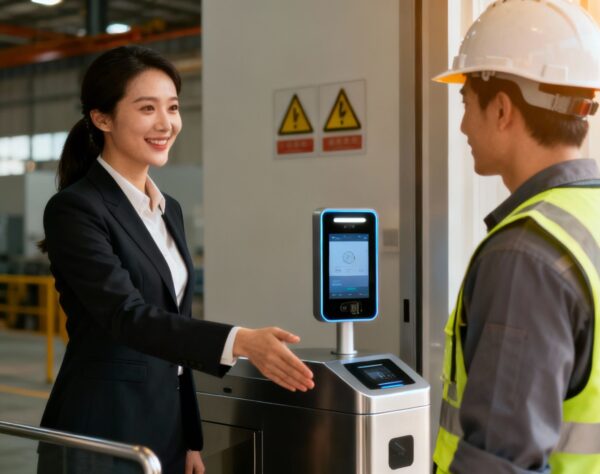Modern Management of Sports Facilities Guide
Running a sports facility used to be straightforward: keep the lights on, the fields green, and the doors open. That's not the game anymore. Today, effective management of sports facilities means creating dynamic, safe, and engaging community hubs. You're no longer just a caretaker; you are the architect of an experience.
The New Playbook for Managing Sports Facilities
Modern sports venues are complex ecosystems. Just like a championship team, every part must work together seamlessly. The old reactive model of putting out fires as they appear is obsolete. Success now demands a proactive strategy that integrates daily upkeep, long-term financial health, and community building into a single, cohesive plan.
The goal is not merely to have a facility that functions. It's to build a venue that thrives as a business and becomes a cornerstone of the local community. Visitors expect clean, modern, and safe environments where they can have a great time, from the moment they arrive to the final whistle.
Core Pillars of Modern Management
To deliver on this promise, managers must juggle several key areas at once. It’s a balancing act where dropping one ball jeopardizes the entire performance. Think of it as the foundation of a sturdy building; getting these pillars right sets you up for success.
A well-run facility is built on three core pillars that work in harmony:
- Operational Excellence: This covers all daily operations: scheduling, staffing, cleaning, and maintenance. It's about ensuring a well-oiled machine for every visitor, every time.
- Financial Sustainability: This pillar focuses on smart money management. It includes disciplined budgeting, creating diverse revenue streams beyond ticket sales, and planning for future capital upgrades.
- Visitor Experience: This is the heart of it all. It’s about creating a welcoming, safe, and engaging atmosphere that turns first-time visitors into a loyal community, driving repeat business.
Here’s a quick overview of how these pillars support a thriving facility.
Core Pillars of Modern Sports Facility Management
| Pillar | Key Focus | Primary Benefit |
|---|---|---|
| Operational Excellence | Daily upkeep, scheduling, maintenance, and staffing. | A smooth, seamless, and professional environment. |
| Financial Sustainability | Smart budgeting, diverse revenue streams, and capital planning. | Long-term viability and growth for the facility. |
| Visitor Experience | Safety, engagement, and creating a welcoming atmosphere. | Increased loyalty, repeat visits, and positive word-of-mouth. |
As you can see, these areas are not separate tasks—they are deeply interconnected. True success is achieved when they are managed as one cohesive unit.

The Economic Impact of Effective Management
Getting this right isn't just about happy visitors; it's big business. The management of indoor sports facilities in the United States alone is a market worth over $1.6 billion. That figure is growing consistently, highlighting the economic muscle of well-run venues.
A well-managed facility is more than just a place to play sports; it becomes a vital economic engine for the community, attracting events, creating jobs, and boosting local businesses.
Of course, a great strategy is one thing; execution is another. This is where the right technology becomes critical. Exploring facility management applications provides your team with the tools to automate tasks and work smarter. By integrating technology for everything from visitor check-ins to maintenance schedules, you can build a more efficient and profitable operation.
Driving Revenue with Smart Operational Strategies

A thriving sports facility is like a high-performance athlete. Just as an athlete needs a smart training regimen to win, your venue needs a robust operational strategy to achieve peak financial performance. Moving beyond ticket sales is key to building a resilient, profitable operation.
Smart management of sports facilities is about unlocking diverse revenue streams that guarantee stability and open avenues for growth.
This financial backbone is more crucial than ever. The global sports facilities market is experiencing incredible growth, with projections showing a 4.8% compound annual growth rate (CAGR). This boom is driven by massive demand for venues that can host everything from professional sports to local training. For those who manage their operations well, the opportunities are immense.
Maximizing Your Calendar with Dynamic Scheduling
An empty facility is a revenue black hole. Every dark hour is a missed opportunity. Dynamic scheduling is the art of squeezing maximum value out of every available minute to boost your bottom line.
This requires a strategic balance between different user groups, such as league play, public access hours, and private rentals. Think of your schedule as a puzzle. Each booking is a different-shaped piece, and your job is to fit them together perfectly, leaving no gaps.
A well-structured schedule doesn't just fill empty slots; it transforms your venue into a vibrant, multi-use hub that serves the entire community while maximizing revenue.
Expanding Beyond Traditional Revenue Streams
If your financial plan rests solely on game-day revenue, you're on shaky ground. The most successful facilities diversify their income. This approach not only provides a financial cushion during the off-season but also weaves your facility into the local economic fabric.
Here are a few proven strategies to broaden your financial base:
- Corporate Sponsorships: Don't just sell tickets; sell visibility. Partner with businesses for branding opportunities, from digital signage to naming rights for fields or courts.
- Hosting Non-Sporting Events: Your space is more than a field. Transform it to host corporate meetings, trade shows, concerts, and community festivals, opening your doors to new audiences and revenue.
- Concessions and Merchandise: Elevate your food, drink, and merchandise offerings. A great visitor experience often includes a purchase, capturing valuable on-site spending.
- Youth Sports Programming: Instead of waiting for bookings, develop and run your own camps, clinics, and leagues. This creates consistent revenue and builds a pipeline of future customers.
By diversifying your income, you transform your facility from a single-purpose venue into a year-round destination. This financial resilience is the hallmark of modern, effective sports facility management.
The Importance of Proactive Maintenance and Budgeting
A strong operational strategy is built on proactive maintenance and smart budgeting. This isn't just about fixing things when they break; it's about anticipating problems to protect your most valuable assets. A well-kept facility is safer, more attractive, and cheaper to run long-term.
Your budget needs to cover both day-to-day operational costs and long-term capital improvements. This foresight ensures you have funds for everything from routine turf care to a major roof repair. A structured plan is a must. For a great example, review a commercial-grade maintenance checklist.
This dual focus on today's needs and tomorrow's investments is what separates a good facility from a great one. It protects your venue, impresses your visitors, and secures your financial future.
Enhancing the Visitor Experience with Technology
A visitor's experience is one of the most powerful assets any venue has. It's the difference between a one-time ticket buyer and a lifelong fan. Technology bridges the gap between a standard visit and a memorable event, shifting management of sports facilities from reactive problem-solving to proactive engagement.
Forget complex features; let's focus on what modern tech actually does. It's about creating a smooth, frictionless journey for every person, from the parking lot to the moment they head home.
Streamlining the Arrival and Entry Process
First impressions are everything. Nothing kills excitement faster than long, confusing lines at the gate. A modern visitor management system eliminates this frustration by automating check-in, creating a welcoming entry that sets a positive tone for the day.
This isn’t just about faster entry; it’s about making guests feel valued. A smooth arrival respects their time and signals a professional, well-run facility. In fact, research shows that 74% of customers are more likely to stay with a brand if the process is easy.
A frictionless entry provides several key benefits:
- Reduced Wait Times: Guests spend less time in a queue and more time enjoying the event, directly boosting satisfaction.
- Enhanced Security: An automated system provides a safer environment without intrusive manual checks by instantly verifying tickets and credentials.
- Efficient Crowd Flow: Faster entry prevents dangerous bottlenecks at gates and keeps everyone moving smoothly, a significant safety advantage.
When you remove friction at the front gate, you're not just moving people through an entrance. You're building a better, safer experience that creates immediate goodwill.
This is where you can see the real benefits of a visitor management system come to life. These systems create a seamless flow from start to finish, and understanding their application is a game-changer for large venues.
Turning Data into Actionable Insights
Imagine knowing your facility's busiest times without guessing, or adjusting staffing based on real-time crowd movement. That's the power of data. Smart tech, like IoT sensors and analytics platforms, gathers anonymous data on visitor flow.
This information is operational gold. It helps you spot bottlenecks, identify underused areas, and see which concession stands are drawing the biggest crowds.
This data-driven approach allows you to:
- Optimize Staffing: Deploy your team exactly where and when they are needed most, improving service and controlling labor costs.
- Predict Maintenance Needs: Identify high-traffic zones that experience more wear and tear, allowing you to schedule proactive maintenance before a breakdown.
- Personalize the Guest Journey: Imagine sending a timely promo for a nearby food vendor to a fan's phone based on their location, making their visit more interactive.
This focus on smarter infrastructure is a massive trend. The global sports facilities design market is expected to grow at a Compound Annual Growth Rate (CAGR) of 4.5%, driven by investments in modernizing these systems.
Ultimately, using technology to elevate the visitor experience builds the loyalty that creates repeat business and incredible word-of-mouth. It's about making every visitor feel like a VIP, ensuring they leave with amazing memories.
Building a Culture of Safety and Compliance
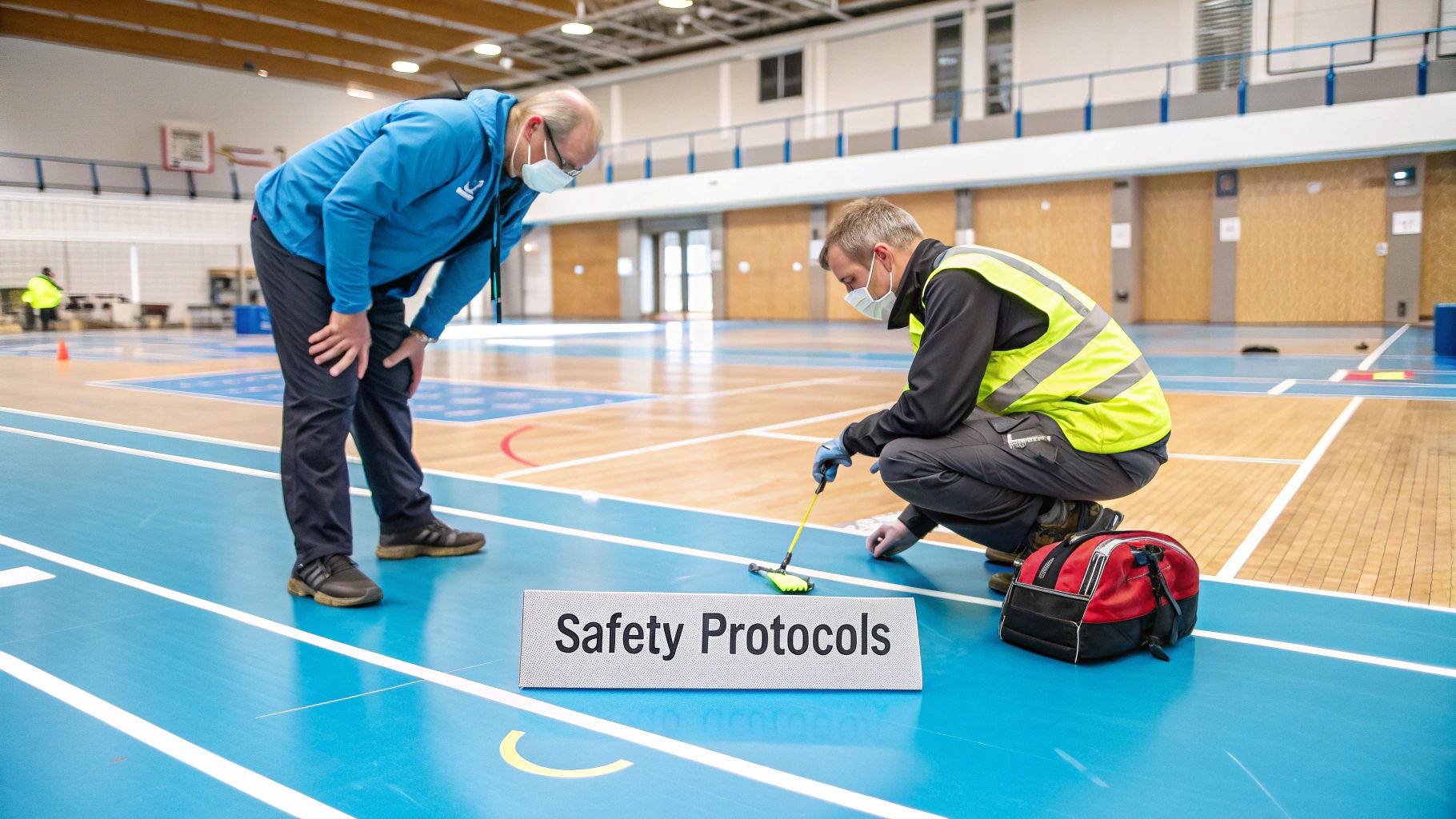
In the world of sports, trust is everything. When visitors, athletes, and staff enter your facility, they trust you to provide an environment that is not just exciting, but fundamentally safe. This is the cornerstone of exceptional management of sports facilities. It all starts with a culture where safety and compliance are integrated into every decision.
A secure facility is the result of a deliberate shift from a reactive mindset—fixing problems after they cause trouble—to a proactive one. The goal is to get ahead of the game by spotting and neutralizing potential hazards before they can cause harm.
Moving from Reactive to Proactive Maintenance
The old "if it ain't broke, don't fix it" model is a recipe for disaster. It is not just dangerous; it is expensive. Unplanned downtime, emergency repairs, and liability claims will always cost more than a proactive maintenance plan. In fact, studies show that a proactive strategy can slash overall maintenance costs by 12% to 18%.
This approach means scheduled inspections, using data to predict equipment failure, and keeping a detailed log of every issue. It is the difference between replacing a frayed cable before it snaps and dealing with an equipment failure during a sold-out event.
This shift doesn't just protect your visitors; it protects your budget and cements your facility's reputation as a reliable community hub.
Developing and Implementing Essential Safety Protocols
A genuine safety culture is built on clear, well-rehearsed protocols covering everything from daily procedures to worst-case scenarios. Keeping everyone safe requires robust measures, from comprehensive security solutions to clear procedural guides. Every team member, from the ticket scanner to the general manager, must know their role.
Key safety protocols should always include:
- Routine Equipment Inspections: Create detailed checklists for all assets—sports equipment, bleachers, lighting, and structures. These checks must be performed and documented consistently.
- Emergency Response Plans: Develop clear, actionable plans for medical incidents, fires, and security threats. Regular drills are the only way to ensure staff can execute these plans effectively under pressure.
- Crowd Management Procedures: Implement smart strategies for managing people flow during peak times to prevent dangerous overcrowding and ensure safe entry and exit.
A well-documented safety plan is more than a binder on a shelf. It's a living guide that empowers your team to act decisively, ensuring every visitor's well-being is the top priority.
A solid plan is the first step. For a deeper dive, exploring best practices for emergency evacuation procedures in the workplace offers valuable insights for strengthening your own protocols.
Navigating the Complexities of Compliance
Beyond physical safety, your facility must operate within a complex web of legal and regulatory requirements. This is a fundamental part of responsible management that shields your organization from legal and financial headaches. A single compliance failure can lead to heavy fines, lawsuits, and irreparable reputational damage.
Staying current means being diligent in several key areas:
- Accessibility Standards: Regulations like the Americans with Disabilities Act (ADA) are non-negotiable. Your facility must be accessible to everyone, with proper ramps, seating, and restrooms.
- Health and Safety Regulations: You must follow local health codes for concessions, maintain strict sanitation standards, and adhere to official occupancy limits.
- Insurance and Liability: Carrying the right insurance is critical. A strong, proactive safety culture often leads to lower premiums by demonstrating active risk minimization to insurers.
When you weave safety and compliance into your operational DNA, you're not just ticking boxes. You’re building a resilient organization, protecting your community, and cementing your reputation as a place people can trust.
Fostering a Winning Team and Engaged Community
You can have pristine turf and the newest scoreboard, but the real power of any sports venue is its people. Great management of sports facilities means understanding that your buildings are just containers; the staff and community fill them with life.
Long-term success boils down to two things: building a motivated, high-performing team and creating deep, lasting bonds with the community you serve.
These two goals are sides of the same coin. An empowered team creates positive interactions that make everyone feel welcome. In turn, an engaged community provides the loyal support that turns a facility from a building into a beloved local institution. It's a powerful cycle that builds both a stellar reputation and a healthy bottom line.
Building Your All-Star Internal Team
Your staff are the face of your facility. They deliver the first hello and the final goodbye for every person who walks through your doors. Investing in them is a direct investment in your guest experience.
It’s no surprise that companies with highly engaged employees achieve 23% higher profitability than their competitors.
This doesn't happen on its own. It requires a deliberate strategy focused on hiring the right people and giving them the tools and training to shine.
To cultivate a winning internal culture, focus on these areas:
- Hire for Passion, Train for Skill: You can teach someone new software, but you can't teach a genuine passion for service. Look for candidates who are naturally positive and eager to create fantastic experiences.
- Empower with Ongoing Training: Training shouldn't be a one-time event. Provide continuous development on everything from new tech to conflict resolution. Confident employees provide better service.
- Recognize and Reward Excellence: A simple "thank you" goes a long way, but a formal recognition program can be a game-changer. Celebrating staff who go the extra mile boosts morale and reinforces desired behavior.
Think of it like coaching a sports team. You must recruit the right talent, run effective practices (training), and celebrate wins to keep everyone motivated and playing for the same goal.
Becoming the Heartbeat of the Community
A sports facility should be more than a place to play games—it should be a central hub of community life. When you make your venue the go-to spot for local activity, you build a level of loyalty no marketing budget can buy. This deep connection makes your facility an indispensable community asset.
Forging these bonds requires you to actively reach out and become a true partner. It’s about listening to what residents, teams, and families want and designing programs that meet their needs. That's how your venue becomes an integral part of their lives.
Strategies for Deep Community Integration
Making your facility a community cornerstone is about strategic partnerships and inclusive programming. It's about opening your doors and inviting everyone in.
The two sides of this coin—your internal team and your external community—are deeply connected. A strong team is better equipped to serve the community, and a happy community makes for a more rewarding work environment.
Take a look at how staff-focused actions directly support your community-facing goals.
Staffing vs. Community Engagement Strategies
This table breaks down how specific initiatives can build up your internal team while simultaneously strengthening your ties to the external community.
| Initiative Area | Staff-Focused Action | Community-Focused Action |
|---|---|---|
| Partnerships | Cross-train staff with local league officials to ensure smooth game-day operations. | Forge formal partnerships with schools and youth sports leagues for priority booking and co-hosted events. |
| Programming | Empower staff to pitch and lead new program ideas, like a "staff vs. community" charity game. | Host diverse events beyond sports, such as farmers' markets, local festivals, or outdoor movie nights. |
| Communication | Create an internal newsletter celebrating team successes and sharing community feedback. | Maintain an active social media presence highlighting community members and local team achievements. |
| Inclusivity | Provide staff training on accessibility and creating a welcoming environment for all visitors. | Offer free or low-cost "open house" days to introduce the facility to residents who may not otherwise visit. |
By building this powerful connection, you ensure your facility is not just seen as a business, but as a vital part of your community's identity. This sense of belonging is the ultimate goal of effective management of sports facilities, creating a legacy of support that will last for years.
Answering Your Top Facility Management Questions

Even with the best plans, running a sports facility means facing new questions daily. Getting clear, practical answers to common challenges keeps your operation running smoothly.
This guide tackles the most frequent questions from managers on the ground.
How Can We Generate Revenue During the Off-Season?
An empty facility doesn't have to be a money pit. The key is to stop thinking of your space as only for sports. Get creative, and you can turn your venue into a year-round asset that brings in steady income.
Here are a few proven ideas:
- Host Non-Sporting Events: Think outside the lines. Your facility can be a unique spot for corporate meetings, trade shows, festivals, or even weddings. Businesses are always looking for memorable venues.
- Launch In-House Programming: Why wait for bookings? Run your own camps, clinics, and rec leagues during slower months. This creates a direct revenue stream and builds a loyal following.
- Use Every Inch of Your Space: Could your parking lot host a weekend farmers' market? Can your indoor courts be used for community yoga classes? Using every square foot is the secret to off-season profit.
What’s the Best Way to Maximize ROI on New Technology?
Investing in new tech like a visitor management system can feel like a huge leap. The real return isn't just about cost savings; it's about creating a safer, smoother, and more professional experience for every visitor.
The biggest win from modern tech isn’t a single feature—it's how it makes every visitor feel secure and valued from the moment they arrive. A seamless, welcoming check-in builds the kind of loyalty that brings people back and gets them talking.
To get the best return, look past features and focus on benefits. A good system gives you data on visitor traffic, helping you staff smarter and cut waste. Automating check-ins and safety briefings frees up your team for quality guest interactions. When you learn that facilities with a better guest experience see up to a 16% price premium on services, the investment starts to look pretty smart.
How Do We Choose the Right Visitor Management System?
Picking the right system becomes easier when you focus on what you need. The goal is to find a tool that solves your biggest headaches, whether that’s long check-in lines, security worries, or compliance paperwork.
Think about how each option supports your long-term goals.
For a complete guide, check our post on how to choose a visitor management system. It’s packed with practical advice to help you pick a tool that truly works for your facility.
How Can We Ensure Compliance with Changing Safety Standards?
Safety rules are always evolving, and staying current requires a proactive approach. Start by assigning a person or team to monitor updates from regulators.
Then, conduct regular internal audits of your facility and procedures, comparing them against the latest standards. Document everything, from fire extinguisher checks to staff training. This creates a clear paper trail that proves due diligence and helps you spot gaps before they become real problems.
Ready to upgrade your facility's safety and efficiency? VisitUs provides a secure, intuitive visitor management system that automates check-ins, enhances security protocols, and ensures compliance. Discover how our system can transform your operations at https://visit-us.com.
